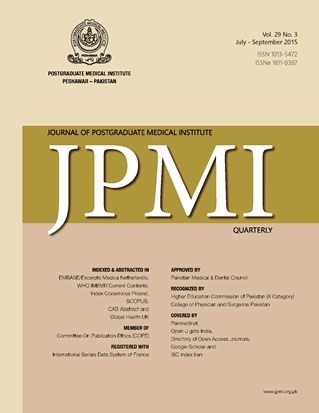PLATELET INDICES AMONG SUBJECTS WITH AND WITHOUT DIABETES MELLITUS AND HYPERTENSION: A CROSS- SECTIONAL ANALYSIS AT KARACHI, PAKISTAN
Main Article Content
Abstract
Objective: To measure differences of platelet indices in subjects with and without diabetes mellitus and hypertension
Methodology: This was a cross-sectional analysis from Jan-11 to Feb-2012.
From a target population of non-pregnant adult subjects being advised a
fasting blood glucose or OGTT for confirming or excluding diabetes, we finally
selected 820 individuals for inclusion into study. Fifty known diabetics were
also included in the study. Subjects were formally interviewed and sampled
for fasting blood glucose, and platelet indices (including platelet count, plate -crit (PCT), mean platelet volume (MPV) and platelet distribution (PDW). The
results of platelet indices were compared between 4 groups based on OGTT.
Platelet indices were also compared between groups based upon post-load
glycemic status and hypertension.
Results: Age and MPV showed slight positive and significant correlations with
fasting blood. [Age: r2=0.117 (p<0.001) and MPV: r2=0.116 (P=0.001); other
platelet indices did not show significant correlations. Out of the 4 platelet in-dices studied, MPV and PCT were found to significantly increase from normo-glycemia to individuals with established diabetes mellitus in one way ANOVA
analysis. Subjects demonstrating post load hyperglycemia (n=47) had high-er mean platelet volumes than individuals having post load normoglycemia
(n=30) [MPV: 9.63 + 1.51vs 8.90 + 0.98, p=0.012]. Hypertensive subjects did
not demonstrate higher MPV results than normotensive subjects in our study.
Conclusion: Mean platelet volume and platecrit increases across various
grades of hyperglycemia. However, the changes become quite prominent in
subjects having established diabetes with marked hyperglycemia. Post load
hyperglycemia was more predictive of rises in mean platelet volumes.
Methodology: This was a cross-sectional analysis from Jan-11 to Feb-2012.
From a target population of non-pregnant adult subjects being advised a
fasting blood glucose or OGTT for confirming or excluding diabetes, we finally
selected 820 individuals for inclusion into study. Fifty known diabetics were
also included in the study. Subjects were formally interviewed and sampled
for fasting blood glucose, and platelet indices (including platelet count, plate -crit (PCT), mean platelet volume (MPV) and platelet distribution (PDW). The
results of platelet indices were compared between 4 groups based on OGTT.
Platelet indices were also compared between groups based upon post-load
glycemic status and hypertension.
Results: Age and MPV showed slight positive and significant correlations with
fasting blood. [Age: r2=0.117 (p<0.001) and MPV: r2=0.116 (P=0.001); other
platelet indices did not show significant correlations. Out of the 4 platelet in-dices studied, MPV and PCT were found to significantly increase from normo-glycemia to individuals with established diabetes mellitus in one way ANOVA
analysis. Subjects demonstrating post load hyperglycemia (n=47) had high-er mean platelet volumes than individuals having post load normoglycemia
(n=30) [MPV: 9.63 + 1.51vs 8.90 + 0.98, p=0.012]. Hypertensive subjects did
not demonstrate higher MPV results than normotensive subjects in our study.
Conclusion: Mean platelet volume and platecrit increases across various
grades of hyperglycemia. However, the changes become quite prominent in
subjects having established diabetes with marked hyperglycemia. Post load
hyperglycemia was more predictive of rises in mean platelet volumes.
Article Details
How to Cite
1.
Khan SH, Ahmad SA. PLATELET INDICES AMONG SUBJECTS WITH AND WITHOUT DIABETES MELLITUS AND HYPERTENSION: A CROSS- SECTIONAL ANALYSIS AT KARACHI, PAKISTAN. J Postgrad Med Inst [Internet]. 2015 Dec. 12 [cited 2025 Dec. 5];29(3). Available from: https://jpmi.org.pk/index.php/jpmi/article/view/1694
Issue
Section
Original Article
Work published in JPMI is licensed under a
Creative Commons Attribution-NonCommercial 2.0 Generic License.
Authors are permitted and encouraged to post their work online (e.g., in institutional repositories or on their website) prior to and during the submission process, as it can lead to productive exchanges, as well as earlier and greater citation of published work.


